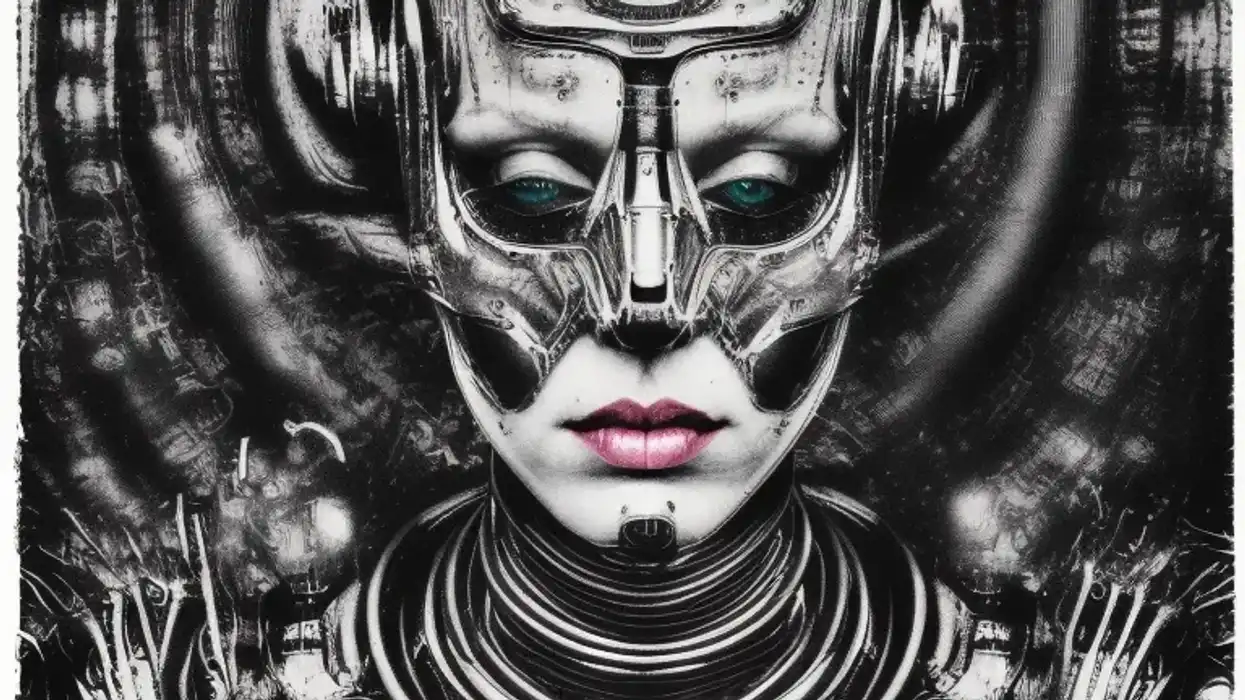
© 2026 Blaze Media LLC. All rights reserved.
Today the trajectory of Science leaves us behind to tally and bear the costs of our technologists’ search for order. In the guise of secular priests, they insist the benchmarks of our human complement are misinformation lingering from less enlightened eras. Even the intellectual frameworks underpinning cognition are described as illusions to be wiped away, our limited human identities one day to follow. But the soul, the essence which makes us human, may prove harder for nihilism—or cybernetics—to destroy.
This is the second part of a two-part essay originally published in issue 2 of RETURN magazine. You can read part one here.
Arendt began the same, decidedly prescient book with the following words:
The human artifice of the world separates human existence from all mere animal environments, but life itself is outside this artificial world, and through life man remains related to all other living organisms. For some time now, a great many scientific endeavors have been directed toward making life also “artificial,” toward cutting the last tie through which even man belongs among the children of nature....
This future man, whom the scientists tell us they will produce in no more than a hundred years, seems to be possessed by a rebellion against human existence as it has been given, a free gift from nowhere (secularly speaking), which he wishes to exchange, as it were, for something he has made himself.
The nanotechnological dream that began to take shape only a few decades after the utterance of Arendt’s prophesy amounts to exactly this revolt against the mortality of the human condition. Human life has an end, for it is promised to death. But not only do the champions of NBIC Convergence oppose themselves to fate, by promising immortality; they quarrel with the very fact that we are born. Their revolt against the given is therefore something subtler and less visible, something still more fundamental, than the revolt against human mortality, for it rejects the notion that we should be brought into the world for no reason.
“Human beings are ashamed to have been born instead of made.” Thus the German philosopher Günther Anders (Arendt’s first husband and himself a student of Heidegger) characterized the essence of the revolt against the given in his great book, published in 1956, Die Antiquiertheit des Menschen – The Antiquatedness (or Obsolescence) of the Human Being. One cannot help recalling here another philosophical emotion: the nausea described by Jean-Paul Sartre, that sense of forlornness that takes hold of human beings when they realize that they are not the foundation of their own being.
The human condition is ultimately one of freedom; but freedom, being absolute, runs up against the obstacle of its own contingency, for we are free to choose anything except the condition of being unfree. Discovering that we have been thrown into the world without any reason, we feel abandoned. Sartre acknowledged his debt to Günther Anders in expressing this idea by means of a phrase that was to become famous: man is “to freedom condemned.”
Freedom, Sartre held, never ceases trying to nihilate that which resists it. Mankind will therefore do everything it can to become its own maker; to owe its freedom to no one but itself. But only things are what they are; only things coincide with themselves. Freedom, on the other hand, is a mode of being that never coincides with itself since it ceaselessly projects itself into the future, desiring to be what it is not.
Self-coincidence is what freedom aspires to and cannot attain, just as a moth is irresistibly attracted to the flame that will consume it. A metaphysical self-made man, were such a being possible, would paradoxically have lost his freedom, and indeed would no longer be a man at all, since freedom necessarily entails the impossibility of transforming itself into a thing. Thus Anders’ notion of “Promethean shame” leads inexorably to the obsolescence of man.
Had they lived to see the dawn of the twenty-first century, Sartre and Anders would have found this argument resoundingly confirmed in the shape of the NBIC Convergence – a Promethean project if ever there was one. The aim of this distinctively metaphysical program is to place mankind in the position of being the divine maker of the world, the demiurge, while at the same time condemning human beings to see themselves as out of date.
At the heart of the nanotechnological dream we therefore encounter a paradox that has been with us since the cybernetic chapter in the philosophical history of cognitive science – an extraordinary paradox arising from the convergence of opposites, whereby the overweening ambition and pride of a certain scientific humanism leads directly to the obsolescence of mankind. It is in the light, or perhaps I should say the shadow, of this paradox that all “ethical” questions touching on the engineering of mankind by mankind must be considered.
“Playing God” versus the blurring of fundamental distinctions

In 1964, Norbert Wiener published an odd book with the curious title God and Golem, Inc.: A Comment on Certain Points Where Cybernetics Impinges on Religion. In it one finds this:
God is supposed to have made man in His own image, and the propagation of the race may also be interpreted as a function in which one living being makes another in its own image. In our desire to glorify God with respect to man and Man with respect to matter, it is thus natural to assume that machines cannot make other machines in their own image; that this is something associated with a sharp dichotomy of systems into living and non-living; and that it is moreover associated with the other dichotomy between creator and creature. Is this, however, so?
The rest of the book is devoted to mobilizing the resources of cybernetics to show that these are false dichotomies and that, in truth, “machines are very well able to make other machines in their own image.”
In recent years, the enterprise of “making life from scratch” has been organized as a formal scientific discipline under the seemingly innocuous name of synthetic biology. In June 2007, the occasion of the first Kavli Futures Symposium at the University of Greenland in Ilulissat, leading researchers from around the world gathered to announce the convergence of work in synthetic biology and nanotechnology and to take stock of the most recent advances in the manufacture of artificial cells.
Their call for a global effort to promote “the construction or redesign of biological systems components that do not naturally exist” evoked memories of the statement that was issued in Asilomar, California more than thirty years earlier, in 1975, by the pioneers of biotechnology. Like their predecessors, the founders of synthetic biology insisted not only on the splendid things they were poised to achieve, but also on the dangers that might flow from them.
Accordingly, they invited society to prepare itself for the consequences, while laying down rules of ethical conduct for themselves. We know what became of the charter drawn up at Asilomar. A few years later, this attempt by scientists to regulate their own research had fallen to pieces. The dynamics of technological advance and the greed of the marketplace refused to suffer any limitation.
Only a week before the symposium in Ilulissat, a spokesman for the ETC Group, an environmental lobby based in Ottawa that has expanded its campaign against genetically modified foods to include emerging nanotechnologies, greeted the announcement of a feat of genetic engineering by the J. Craig Venter Institute in Rockville, Maryland with the memorable words, “For the first time, God has competition.”
In the event, ETC had misinterpreted the nature of the achievement. But if the Ilulissat Statement is to be believed, the actual synthesis of an organism equipped with an artificial genome (“a free-living organism that can grow and replicate”) will become a reality in the next few years. Whatever the actual timetable may turn out to be, the process of fabricating DNA is now better understood with every passing day, and the moment when it will be possible to create an artificial cell using artificial DNA is surely not far off.
The question arises, however, whether such an achievement will really amount to creating life. In order to assert this much, one must suppose that between life and non-life there is an absolute distinction, a critical threshold, so that whoever crosses it will have shattered a taboo, like the prophet Jeremiah and like Rabbi Löw of Prague in the Jewish tradition, who dared to create an artificial man, a golem.
In the view of its promoters and some of its admirers, notably the English physicist and science writer Philip Ball, synthetic biology has succeeded in demonstrating that no threshold of this type exists: between the dust of the earth and the creature that God formed from it, there is no break in continuity that permits us to say (quoting Genesis 2:7) that He breathed into man’s nostrils the breath of life. And even in the event that synthetic biology should turn out to be incapable of fabricating an artificial cell, these researchers contend, it would still have had the virtue of depriving the prescientific notion of life of all consistency.
It is here, in the very particular logic that is characteristic of dreams, that nanotechnology plays an important symbolic role. It is typically defined by the scale of the phenomena over which it promises to exert control – a scale that is described in very vague terms, since it extends from a tenth of a nanometer to a tenth of a micron. Nevertheless, over this entire gamut, the essential distinction between life and non-life loses all meaning.
It is meaningless to say, for example, that a DNA molecule is a living thing. At the symbolic level, a lack of precision in defining nanotechnology does not matter; what matters is the deliberate and surreptitious attempt to blur a fundamental distinction that until now has enabled human beings to steer a course through the world that was given to them. In the darkness of dreams, there is no difference between a living cat and a dead cat.
Once again, we find that science oscillates between two opposed attitudes: on the one hand, vainglory, an excessive and often indecent pride; and on the other, when it becomes necessary to silence critics, a false humility that consists in denying that one has done anything out of the ordinary, anything that departs from the usual business of normal science.
As a philosopher, I am more troubled by the false humility, for in truth it is this, and not the vainglory, that constitutes the height of pride. I am less disturbed by a science that claims to be the equal of God than by a science that drains one of the most essential distinctions known to humanity since the moment it first came into existence of all meaning: the distinction between that which lives and that which does not; or, to speak more bluntly, between life and death.
Let me propose an analogy that is more profound, I believe, than one may at first be inclined to suspect. With the rise of terrorism in recent years, specifically in the form of suicide attacks, violence on a global scale has taken a radically new turn. The first edition of this book belongs to a bygone era, which ended on September 11, 2001.
In that world, even the most brutal persecutor expressed his attachment to life, because he killed in order to affirm and assert the primacy of his own way of living. But when the persecutor assumes the role of victim, killing himself in order to maximize the number of people killed around him, all distinctions are blurred, all possibility of reasoned dissuasion is lost, all control of violence is doomed to impotence.
If science is allowed, in its turn, to continue along this same path in denying the crucial difference that life introduces in the world, it will, I predict, prove itself to be capable of a violence that is no less horrifying.
Among the most extreme promises of nanotechnology, as we have seen, is immortality (or “indefinite life extension,” as it is called). But if there is thought to be no essential difference between the living and the non-living, then there is nothing at all extraordinary about this promise. Yet again, Hannah Arendt very profoundly intuited what such a pact with the devil would involve:
The greatest and most appalling danger for human thought is that what we once believed could be wiped out by the discovery of some fact that had hitherto remained unknown; for example, it could be that one day we succeed in making men immortal, and everything we had ever thought concerning death and its profundity would then become simply laughable. Some may think that this is too high a price to pay for the suppression of death.
The ETC Group’s premonitory observation – “For the first time, God has competition” – can only strengthen the advocates of the NBIC Convergence in their belief that those who criticize them do so for religious reasons. The same phrases are always used to sum up what is imagined to be the heart of this objection: human beings do not have the right to usurp powers reserved to God alone; playing God is forbidden. Often it is added that this taboo is specifically “Judeo-Christian.”
Let us put to one side the fact that this allegation wholly misconstrues the teaching of the Talmud as well as that of Christian theology. In conflating them with the ancient Greek conception of the sacred – the gods, jealous of men who have committed the sin of pride, hubris, send after them the goddess of vengeance, Nemesis – it forgets that the Bible depicts man as co-creator of the world with God. As the French biophysicist and Talmudic scholar Henri Atlan notes in Les étincelles du hasard with regard to the literature about the Golem:
One does not find [in it], at least to begin with, the kind of negative judgment one finds in the Faust legend concerning the knowledge and creative activity of men “in God’s image.” Quite to the contrary, it is in creative activity that man attains his full humanity, in a perspective of imitatio Dei that allows him to be associated with God, in a process of ongoing and perfectible creation.
Within the Christian tradition, authors such as G.K. Chesterton, René Girard, and Ivan Illich see Christianity as the womb of Western modernity, while arguing that modernity has betrayed and corrupted its message. This analysis links up with the idea, due to Max Weber, of the desacralization of the world – its famous “disenchantment” – in regarding Christianity, or at least what modernity made of it, as the main factor in the progressive elimination of all taboos, sacred prohibitions, and other forms of religious limitation.
It fell to science itself to extend and deepen this desacralization, inaugurated by the religions of the Bible, by stripping nature of any prescriptive or normative value. It is utterly futile, then, to accuse science of being at odds with the Judeo-Christian tradition on this point. Kantianism, for its part, conferred philosophical legitimacy on the devaluation of nature by regarding it as devoid of intentions and reasons, inhabited only by causes, and by severing the world of nature from the world of freedom, where the reasons for human action fall under the jurisdiction of moral law.
Where, then, is the ethical problem located, if in fact there is one here? It clearly does not lie in the transgression of this or that taboo sanctioned by nature or the sacred, since the joint evolution of religion and science has done away with any such foundation for the very concept of a moral limitation, and hence of a transgression. But that is precisely the problem.
For there is no free and autonomous human society that does not rest on some principle of self-limitation. We will not find the limits we desperately need in the religions of the Book, as though such limits are imposed on us by some transcendental authority, for these religions do nothing more than confront us with our own freedom and responsibility.
The ethical problem weighs more heavily than any specific question dealing, for instance, with the enhancement of a particular cognitive ability by one or another novel technology. But what makes it all the more intractable is that, whereas our capacity to act into the world is increasing without limit, with the consequence that we now find ourselves faced with new and unprecedented responsibilities, the ethical resources at our disposal are diminishing at the same pace. Why should this be?
Because the same technological ambition that gives mankind such power to act upon the world also reduces mankind to the status of an object that can be fashioned and shaped at will; the conception of the mind as a machine – the very conception that allows us to imagine the possibility of (re)fabricating ourselves – prevents us from fulfilling these new responsibilities. Hence my profound pessimism.
Alcmena’s paradox

To pay Heinz von Foerster a final homage, I would like to conclude by recounting a very lovely and moving story he told me, one that has a direct bearing on the arguments developed here.
The story takes place in Vienna toward the end of 1945, and it concerns another Viennese Jew, the psychiatrist Viktor Frankl, whose celebrated book Man’s Search for Meaning was to be published the following year. Frankl had just returned to Vienna, having miraculously survived the Auschwitz-Birkenau camp; in the meantime he had learned that his wife, his parents, his brother, and other members of his family had all been exterminated. He decided to resume his practice. Here, then, is the story as my friend Heinz told it:
Concentration camps were the setting for many horrific stories. Imagine then the incredulous delight of a couple who returned to Vienna from two different camps to find each other alive. They were together for about six months, and then the wife died of an illness she had contracted in the camp. At this her husband lost heart completely, and fell into the deepest despair, from which none of his friends could rouse him, not even with the appeal “Imagine if she had died earlier and you had not been reunited!” Finally he was convinced to seek the help of Viktor Frankl, known for his ability to help the victims of the catastrophe.
They met several times, conversed for many hours, and eventually one day Frankl said: “Let us assume God granted me the power to create a woman just like your wife: she would remember all your conversations, she would remember the jokes, she would remember every detail: you could not distinguish this woman from the wife you lost. Would you like me to do it?” The man kept silent for a while, then stood up and said, “No thank you, doctor!” They shook hands; the man left and started a new life.
When I asked him about this astonishing and simple change, Frankl explained, “You see, Heinz, we see ourselves through the eyes of the other. When she died, he became blind. But when he saw that he was blind, he could see!”
This, at least, is the lesson that von Foerster drew from this story – in typical cybernetic fashion. But I think that another lesson can be drawn from it, one that extends the first. What was it that this man suddenly saw, which he did not see before? The thought experiment that Frankl invited his patient to perform echoes one of the most famous Greek myths, that of Amphitryon. In order to seduce Amphitryon’s wife, Alcmena, and to pass a night of love with her, Zeus assumes the form of Amphitryon. From Monique Canto-Sperber’s “love” entry in her Dictionnaire d’éthique et de philosophie morale:
All through the night, Alcmena loves a man whose qualities are in every particular identical to those of her husband. The self-same description would apply equally to both. All the reasons that Alcmena has for loving Amphitryon are equally reasons for loving Zeus, who has the appearance of Amphitryon, for Zeus and Amphitryon can only be distinguished numerically: they are two rather than one. Yet it is Amphitryon whom Alcmena loves and not the god who has taken on his form. If one wishes to account for the emotion of love by appeal to arguments meant to justify it or to the qualities that lovers attribute to the objects of their love, what rational explanation can be given for that “something” which Amphitryon possesses, but that Zeus does not, and which explains why Alcmena loves only Amphitryon, and not Zeus?
When we love somebody, we do not love a list of characteristics, even one that is sufficiently exhaustive to distinguish the person in question from anyone else. The most perfect simulation still fails to capture something, and it is this something that is the essence of love – this poor word that says everything and explains nothing. I very much fear that the spontaneous ontology of those who wish to set themselves up as the makers or recreators of the world know nothing of the beings who inhabit it, only lists of characteristics. If the nanobiotechnological dream were ever to come true, what still today we call love would become incomprehensible.
Jean-Pierre Dupuy is a Professor of Social and Political Philosophy at the École Polytechnique, Paris. He is the Director of research at the C.N.R.S. (Philosophy) and the Director of C.R.E.A. (Centre de Recherche en Épistémologie Appliquée), the philosophical research group of the École Polytechnique, which he founded in 1982. At Stanford University, he is a researcher at the Study of Language and Information (C.S.L.I.).
Want to leave a tip?
We answer to you. Help keep our content free of advertisers and big tech censorship by leaving a tip today.
Want to join the conversation?
Already a subscriber?
more stories
Related Content
© 2026 Blaze Media LLC. All rights reserved.
Get the stories that matter most delivered directly to your inbox.
By signing up, you agree to our Privacy Policy and Terms of Use, and agree to receive content that may sometimes include advertisements. You may opt out at any time.






